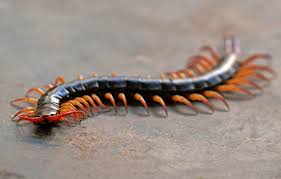Identifying and Treating a Centipede Bite
Centipede bites in humans
Centipedes are carnivorous and venomous. They sting and eat their prey, which typically consists of insects and worms. They’re not aggressive towards humans, but may bite you if you provoke them.
Centipede bites can be very painful to people. The larger the centipede, the more painful their bite may be. All centipedes use venom to kill their prey. Centipede bites rarely cause health complications in humans, and aren’t typically dangerous or fatal.
However, some centipedes have venom which produces a variety of toxins, including chemicals such as histamine, serotonin, and cardio-depressant toxin-S. While it’s rare for centipede bites to have systemic effects, it’s important to know that these toxins can cause potentially serious allergic reactions in people with allergies to bee and wasp stings, as well as significant cardiovascular neurologic effects.
Read on to learn more about identifying and treating a centipede bite.
What do centipedes look like?
Centipedes can range in size from under 1 inch to 7 inches long. Centipedes can have as few as 15 pairs of legs or as many as 177. Centipedes always have an odd number of legs.
Centipedes prefer dark, damp places and wet climates, although they can survive in deserts and other dry areas. They can be found practically all over the globe.
In North America, centipedes have adapted to a wide range of environmental conditions, including deserts, swamplands, and urban sprawls. Their habitats include:
basements
floor drains
cement blocks
crawl spaces
forests
gardens
They may be found under rotted logs or rocks and in potted plants. They can also be found underwater and in caves, thousands of feet below ground.
How do centipedes bite or sting?
Centipedes bite by puncturing skin with clawed, pointy legs located on their first body segment. They may bite if they’re picked up or handled roughly. They may also bite if you accidentally step on one.
All centipedes have the ability to bite, although some smaller species are not strong enough to puncture human skin.
What does a centipede bite look like?

What are the symptoms of a centipede bite?
Centipede bites can be identified by two puncture marks where they inject their venom into the skin. The area around the bite may become red and swollen.
The amount of pain you feel will be determined by the amount of venom injected into the bite. Smaller centipedes deliver very little venom. Their bites may be comparable to bee stings in terms of pain. Larger centipedes may deliver more venom, causing intense pain.
Pain, redness, and swelling begin immediately upon being bitten. These symptoms may last anywhere from several hours to several days.
Other symptoms may also occur and could indicate a severe allergic reaction, including:
fever
chills
nausea
extreme swelling at the site of the bite
swollen lymph nodes
heart palpitations
itching
See a doctor if you suspect a severe reaction. There has been at least one recorded incidentof anaphylaxis associated with a centipede bite. However, anaphylaxis and other severe complications are very rare, even in people bitten by the largest varieties of centipedes. As of this date, there is only one substantiated fatalityTrusted Source caused by a centipede bite, dating back to 1932.
What should you do if you’ve been bitten by a centipede?
Centipede bites may look similar to bites from other more dangerous insects. If you aren’t sure what bit you, see a doctor, especially if your symptoms are severe.
If there are no complications, treatment for centipede bites focus on symptom relief, and may be treated at home:
Apply heat to the bite as quickly as possible. Immersing the wound in hot water or using hot compresses dilutes venom.
Ice packs can be used to reduce swelling.
Use medications to reduce pain, allergic reactions, and inflammation. These include antihistamines, anesthetics, and anti-inflammatory drugs.
Centipede bites are wounds. To avoid infection, use a topical antibiotic and keep the site clean and covered.
If your symptoms are severe or don’t improve within a few days, talk to your doctor. You may need prescription corticosteroids.
What complications can occur from a centipede bite?
Complications from centipede bites may result from infection or from damage to the skin and tissue where the bite occurred. Your doctor may give you a tetanus shot or, if they suspect infection, prescribe antibiotics.
Let your doctor know if your symptoms worsen or don’t go away within 48 hours. Also let your doctor know if you start running a fever, see red streaks near the wound site, or notice a foul odor.
Allergic reactions may also occur. Intense itching, dizziness, hives, or a rash may be signs of an allergic reaction. If you have swelling of the lips, throat, mouth, or tongue, call your local emergency services or have someone take you to an emergency room immediately.
Conclusion
Centipedes bites, while painful, rarely cause severe health complications in people. At-home treatments can be effective at reducing pain and symptoms. If your symptoms worsen, you have signs of infection, or an allergic reaction, seek medical help.
Source: https://www.healthline.com




.jpeg)



Comments
Post a Comment